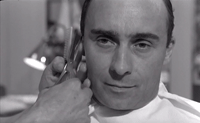I knew almost immediately that I liked Letter from an Unknown Woman (1948). The film’s opening shot establishes a primary location and a mood that’s pure Max Ophüls’ (credited here as “Max Opuls”), whose ability within the subgenre of melodrama is almost unparalleled. Yes, I’ve noted my distaste for this type of movie in the past, but in Ophüls’ capable hands drama actually feels as if it’s bigger than life, rather than just being projected that way. This is the last of his four entries on the 1001 list that I had left to view, and in a way I’m saddened by that fact. This piece is better, much better, than his effort from one year later, The Reckless Moment (1949; #108), but not quite the work that his The Earrings of Madame de… (1953) is. Still, it’s a fantastic film, and one that throughout, expresses the beauties of cinema.

That opening shot descends upon the dark exterior of a European apartment as a carriage pulls to its door.
Text on screen reads “
Vienna – about 1900.”
Rain pours as drunken pianist Stephan (Louis Jourdan) exits the coach, questioned by his friends about his appearance at a duel early the following day.
“I don’t mind so much being killed, but you know how hard it is for me to get up in the morning” he responds slyly, with only a hint of melancholy.
Ascending the stars to his rooms he is greeted by his mute butler who presents him with a letter that was delivered during the night.
Planning to avoid the duel, Stephan orders the butler to pack his things, but his attention is quickly turned to the letter and its opening words, “By the time you read this I may be dead.” The continued contents of the note unfold in flashback as a female voiceover (Joan Fontaine) divulges the secrets of her longstanding love for Stephan. As a child, its author, Lisa, lived in the apartment across from his. Though he took little notice of her, she became wholly infatuated with him. She stayed up nights, listening to him play the piano and compose his music, imagining being held in his arms. She snuck into his apartment once, simply to be near his things.
When she grew her mother’s marriage moved her away from
Vienna, but her infatuation only deepened.
Though she was courted by a man from a good military family, her heart always belonged to him.
She returned to the city, just to be near him, never knowing if he even knew she existed.
Almost by chance, Stephan approached her once, when she intended to be watching him from afar.
The two had a passionate one night stand; one of many for him, but a lone instance for her.
Though he promised to find her after a brief business trip, his call never came.
Ten years later, having bourn his son and raised him alone, she was married to a prominent member of
Vienna society.
Unrecognized, she met Stephan once again at the opera.
Still feeling the bond between them and a love that never ceased, she almost fell victim to his charms again, until she knew that, for a second time, she would be just another forgotten conquest.
Devastated and ashamed, she sends their son away for a time, but on the train they both catch an epidemic of typhus.
The letter Stephan reads has been composed next to his dying son, and its words end abruptly followed by a note.
A nun has written that the letter’s author expired, whispering his name with her last breath.
Letter from an Unknown Woman is a film of great themes, returned to often by Ophüls. White flowers appear throughout the narrative, seeming to symbolize Lisa herself, and the repeated use of a set of stairs to highlight the separation of the two primary characters is prominent. One such scene stands out, as Lisa has returned to Stephan’s apartment to confess her love, only to see him ascending the semi-spiraled void with another woman.
As well as being visually arresting, the film also must have been quite controversial for its time. Not so subtle playboy antics, adultery, and a child born out of wedlock weren’t everyday fare for 1940s motions pictures, especially Hollywood star vehicles. And oh how those stars shine here. Jourdan, who worked steadily into the early 1990s, never had a better performance that I can recall, and Fontaine is absolutely enchanting as Lisa. This is the type of film that actors must have prayed for, with its ironies and its devastating love story. No wonder that it remains Fontaine’s favorite.
Language: English
Runtime: 86 Minutes
Available @ Youtube.com
Grade: 3.5 Hats Off
 The early footage consists of a brief slice of daily life for the Haukas, mostly migrant workers finding day labor jobs that serve the colonial economy of
The early footage consists of a brief slice of daily life for the Haukas, mostly migrant workers finding day labor jobs that serve the colonial economy of 










